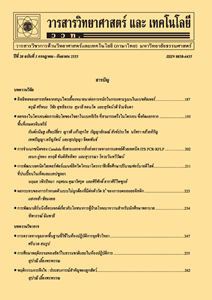การเปรียบเทียบประสิทธิภาพช่วงความเชื่อมั่นสำหรับการประมาณพารามิเตอร์ค่าสัดส่วนทวินาม
Main Article Content
Abstract
บทคัดย่อ
การวิจัยครั้งนี้มีวัตถุประสงค์เพื่อเปรียบเทียบประสิทธิภาพวิธีการประมาณแบบช่วงความเชื่อมั่น 95 % สำหรับพารามิเตอร์ค่าสัดส่วนทวินาม 5 วิธี ได้แก่ วิธีวาลด์ วิธีสคอร์ วิธีสูตรแม่นยำ วิธีเจฟเฟรย์ และวิธีวางนัยทั่วไปสคอร์ ซึ่งเกณฑ์ที่ใช้ในการเปรียบเทียบประสิทธิภาพ คือ ค่าความน่าจะเป็นครอบคลุมและค่าความกว้างเฉลี่ยของช่วงความเชื่อมั่น จำลองข้อมูลโดยใช้เทคนิคมอนติคาร์โลให้มีการแจกแจงทวินามด้วยพารามิเตอร์ n และ p ซึ่งกำหนดขนาดตัวอย่าง (n) 3 กลุ่ม คือ ตัวอย่างขนาดเล็ก (n = 10 และ 15) ตัวอย่างขนาดกลาง (n = 30 และ 50) ตัวอย่างขนาดใหญ่ (n = 100 และ 500) กำหนดพารามิเตอร์ p มีค่าเท่ากับ 0.05, 0.10, 0.30, 0.50, 0.70 และ 0.90 ในแต่ละสถานการณ์ทดลองซ้ำ 2,000 ครั้ง ผลการวิจัยสรุปได้ดังนี้ วิธีเจฟเฟรย์มีแนวโน้มให้ประสิทธิภาพดีเกือบทุกสถานการณ์ ยกเว้นพารามิเตอร์ p มีค่าเท่ากับ 0.5 และในเกือบทุกระดับของขนาดตัวอย่าง n วิธีสคอร์จะมีประสิทธิภาพดี สำหรับวิธีวางนัยทั่วไปสคอร์ ให้ค่าความกว้างเฉลี่ยของช่วงความเชื่อมั่นไม่แตกต่างจากวิธีสคอร์ แต่ให้ค่าความน่าจะเป็นครอบคลุมเป็นไปตามที่กำหนดไว้ดีกว่าวิธีสคอร์ นอกจากนี้วิธีวาลด์มีแนวโน้มให้ประสิทธิภาพดีเมื่อตัวอย่างมีขนาดใหญ่ (n = 100) และพารามิเตอร์ p มีค่าเท่ากับ 0.1 หรือ 0.9
คำสำคัญ : การประมาณแบบช่วงความเชื่อมั่น; พารามิเตอร์ค่าสัดส่วนทวินาม; ค่าสัมประสิทธิ์ความเชื่อมั่น; ค่าความกว้างเฉลี่ยของช่วงความเชื่อมั่น
Abstract
The objective of this research is to compare the efficiencies of 95% confidence intervals of five Methods–Wald method, score method, rigorous formula method, Jeffreys method and generalized score method–for a binomial proportion parameter. The criteria for a performance comparison in this study are the coverage probability and the average width of the confidence interval. Monte Carlo simulation is conducted for dataset in the form of binomial distribution with parameters of n and p. The studied factors consist of the three groups of sample size (n) as follows: the small sample size which is n = 10 and 15, the medium sample size which is n = 30 and 50, and the large sample size which is n = 100 and 500. In addition, the proportion parameter p is defined at 0.05, 0.10, 0.30, 050, 0.70 and 0.90. There are 2,000 repetitions for each situation. The conclusions of this research are as follows: The Jeffreys method tends to have a good performance for almost all situations except the parameter p is equal to 0.5 and almost all levels of the sample size n. In this excepted situations, the score method tends to have a good performance. The average width of the generalized score method seems to have no difference from this of the score method, but the coverage probability of the generalized score method seems better. Furthermore, the Wald method seems to have a good performance for a large sample size n which is greater than 100 and the parameter p is equal to 0.10 or 0.90.
Keywords: confidence interval estimation; binomial proportion parameter; confidence coefficient; average width of the confidence interval


